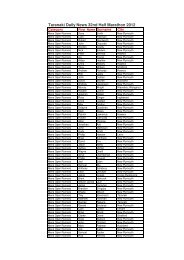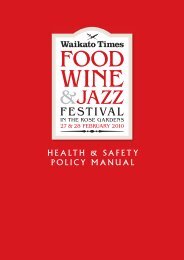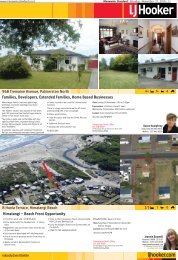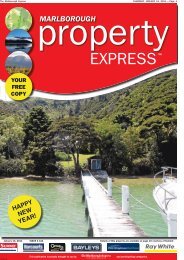Christchurch Central Recovery Plan - New Zealand Listener
Christchurch Central Recovery Plan - New Zealand Listener
Christchurch Central Recovery Plan - New Zealand Listener
- No tags were found...
Create successful ePaper yourself
Turn your PDF publications into a flip-book with our unique Google optimized e-Paper software.
Executive SummaryWhakarāpopototanga MatuaThe Canterbury earthquakes have provided an unprecedented opportunity to rethink, revitalise and renew central<strong>Christchurch</strong>. The area can be built back better than it was before, increasing its value to the wider city, the Canterburyregion, and <strong>New</strong> <strong>Zealand</strong> as a whole. This opportunity is too good to pass up and the <strong>New</strong> <strong>Zealand</strong> Government inpartnership with <strong>Christchurch</strong> City Council and Te Rūnanga o Ngāi Tahu is committed to making the most of it.The vision is for central <strong>Christchurch</strong>to become the thriving heart of aninternational city. It will draw on itsrich natural and cultural heritage, andthe skills and passion of its people, toembrace opportunities for innovation andgrowth. Building on the <strong>Christchurch</strong> CityCouncil’s draft <strong>Central</strong> City <strong>Plan</strong>, and onover 106,000 ideas submitted by thecommunity during the public consultationprocess, this <strong>Recovery</strong> <strong>Plan</strong> sets out howthat vision can be achieved. The <strong>Plan</strong>defines the form of the central city, setsout the locations of key anchor projectsneeded to optimise recovery, and outlinesblock plans which show what the citycould look like in the future.During the <strong>Plan</strong>’s development, advicewas sought on proposed projects fromnumerous community groups andorganisations, such as the CommunityForum. The <strong>Plan</strong>’s proposals are in linewith international benchmarks for a majorcity and make the most of the opportunityto revisit the city’s design. In support of thealready powerful Canterbury economy, the<strong>Plan</strong> also commits significant resourcesto develop central <strong>Christchurch</strong> into avibrant, well-formed centre that respondsto the needs not just of our generation,but also of those that follow.International experience shows thatsuccessful recovery from a natural disasteris heavily dependent on substantialredevelopment commencing within threeyears. One year has passed. Speed is ofthe essence.Why recovery?<strong>Christchurch</strong> is deeply woven into <strong>New</strong><strong>Zealand</strong>’s identity, and <strong>New</strong> <strong>Zealand</strong> hasshown the depth of its commitment tothe city and its people over the past 18months.As one of <strong>New</strong> <strong>Zealand</strong>’s oldest cities andthe South Island’s largest, <strong>Christchurch</strong>is known as “the Garden City”, and itholds a special place in <strong>New</strong> <strong>Zealand</strong>’sculture and heritage. For centuries it wasa food basket for the Ngāi Tahu sub-tribe,Ngāi Tūāhuriri, and it is currently hometo around 377,000 people from manydifferent cultures.There are compelling economic reasonsto invest in a new central city. Canterburygenerates about 12 per cent of thenational gross domestic product (GDP),and the productivity of <strong>Christchurch</strong> is keyto the prosperity of the wider Canterburyregion. Historical strengths in many highvaluesectors mean the city can make asubstantial contribution to <strong>New</strong> <strong>Zealand</strong>’seconomic growth, and must continue todo so.<strong>Christchurch</strong> already has many of thefeatures of successful international cities.It is home to the South Island’s biggesthospital, two universities and sevenCrown Research Institutes. It is a keystrategic node in the national transportnetwork. Its airport and seaport – thebusiest in the South Island – play amajor role in getting goods to market,and as a tourism gateway to the SouthIsland. Despite earthquake damage theeconomy continues to perform well,and the underlying physical and socialinfrastructure remains strong. <strong>Christchurch</strong>is extremely well placed to continue itssignificant contribution to the nationaleconomy.The new city centreA well-formed and vibrant city centreproduces economic and social benefitsby bringing people together for business,cultural or social activities. The resultis greater productivity, connectedness,development of human capital, sharing ofideas and a shared identity.The city centre is also an expression of ourheritage – a reflection of where we havecome from, and a vision of what we wantto become. Greater <strong>Christchurch</strong> deservesan exciting and sustainable central citythat attracts permanent residents tolive, work and play in an environmentthat is safe, accessible to everyone andresponsive to future changes.If greater <strong>Christchurch</strong> is to achievethis vision, businesses need to be ableto operate effectively and confidently.Investors need certainty that theirinvestments will be worthwhile, andlocated in the right place to get the bestpossible results.The <strong>Christchurch</strong> <strong>Central</strong> <strong>Recovery</strong> <strong>Plan</strong>provides a framework for redevelopingthe city centre and will allow investorsto identify a range of investmentopportunities. Substantial positive actionis required to establish confidence andmomentum and, alongside central andlocal government investment, attractthe private and philanthropic investmentneeded for a successful recovery.The <strong>Recovery</strong> <strong>Plan</strong>The design concept for the <strong>Recovery</strong> <strong>Plan</strong>is the development of a greener, moreaccessible city with a compact core and astronger built identity. It will also be a cityfor all people and cultures, recognising inparticular Ngāi Tahu heritage and places ofsignificance.Defining a new central city “Core”, andproviding new green space and a range ofcommercial and residential developmentopportunities, the “Frame” will reshapecentral <strong>Christchurch</strong>. Its three components- East, South, and North – each havetheir own distinct character, while UrbanGateways in the north-west and southeastprovide vibrant entry points to thecentral city. Compressing the availablearea in this way addresses the issuesof too much space and potentiallyunconstrained development, while alsoadding high quality urban open space tothe centre. See pages 33-37 for moreinformation.Through use of the Frame, the Blueprint<strong>Plan</strong> sets out a distinctive, accessibleand connected central city. The blueprintalso lays out precincts and initial anchorprojects to catalyse investment, growthand social energy, bringing people backinto the central city.3<strong>Christchurch</strong> <strong>Central</strong> <strong>Recovery</strong> <strong>Plan</strong>















